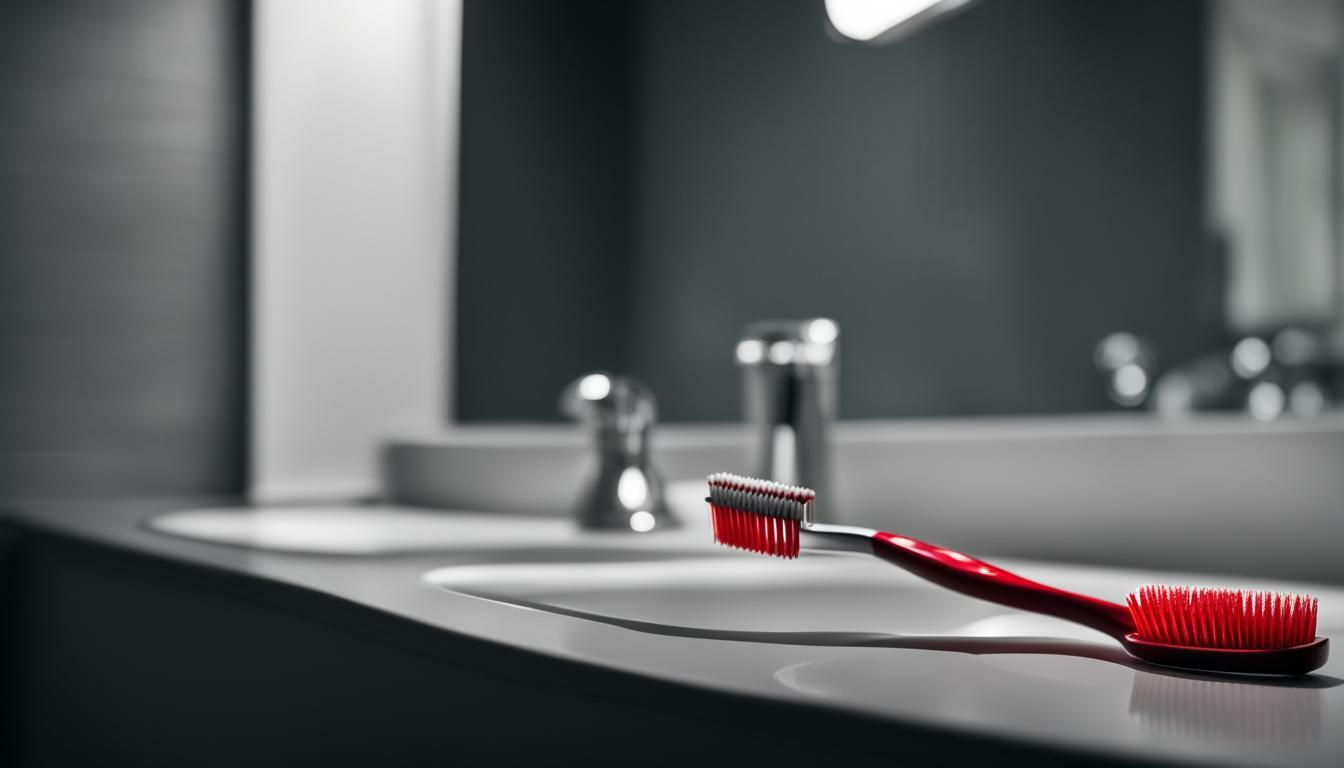Many people wonder if using a toothbrush can actually cause a sore throat. While there is some debate surrounding this topic, it is important to separate fact from fiction when it comes to dental hygiene and its potential impact on throat health.
Contents
Key Takeaways:
- Using a toothbrush cannot directly cause a sore throat from viral illnesses like colds and flu.
- If you have a bacterial illness like strep throat, it is possible to reinfect yourself if your toothbrush has been colonized by the bacteria.
- Keeping your toothbrush clean and properly stored can help reduce the risk of bacterial reinfection.
- Rinsing your toothbrush thoroughly after each use and allowing it to air dry can help prevent bacterial growth.
- It is recommended to replace your toothbrush every three to four months or when the bristles become frayed or matted.
Now that we have addressed the common concerns and misconceptions regarding toothbrushes and their impact on throat health, let’s explore the possible connection between toothbrush use and experiencing a sore throat in more detail.
The Connection Between Toothbrush and Sore Throat
While it may seem unlikely, there are some factors to consider when it comes to the potential connection between using a toothbrush and developing a sore throat. It is commonly believed that toothbrushes can be a source of reinfection after an illness, but this is only true for bacterial illnesses like strep throat. Viral illnesses, such as colds and flu, cannot be transferred through toothbrushes.
To understand how a toothbrush could potentially cause a sore throat, it is important to consider the role of bacteria. If you have a bacterial illness and your toothbrush has been colonized by the bacteria, using it can reintroduce the pathogens into your system, prolonging your illness or leading to reinfection. It is crucial, therefore, to keep your toothbrush clean and free from bacterial colonization.
To maintain good dental hygiene and reduce the risk of throat discomfort, it is recommended to rinse your toothbrush thoroughly after each use and allow it to air dry. It is also advisable to store your toothbrush in an upright position, away from the toilet, as the bathroom environment can harbor bacteria and viruses. Additionally, replacing your toothbrush every three to four months is important, as frayed or matted bristles can harbor bacteria and may cause irritation to your throat.
While the connection between using a toothbrush and developing a sore throat may not be immediately apparent, taking proper care of your toothbrush and practicing good dental hygiene can help prevent potential throat issues. By keeping your toothbrush clean and replacing it regularly, you can ensure that your oral care routine supports your overall throat health.
| Key Takeaways: |
|---|
| – Toothbrushes cannot cause sore throats, but they can potentially reinfect you if you have a bacterial illness. |
| – Rinsing your toothbrush thoroughly and allowing it to air dry can help prevent bacterial colonization. |
| – Storing your toothbrush away from the toilet and replacing it every three to four months is recommended for optimal throat health. |
Debunking the Myths: Toothbrush Reinfection
There is often confusion about whether using a toothbrush can actually reinfect you after an illness. While it is true that toothbrushes can harbor bacteria, it is important to understand the specific circumstances under which reinfection can occur.
When it comes to viral illnesses like colds and flu, reinfection through a toothbrush is highly unlikely. Viruses do not survive for long periods outside of the body, and they typically cannot multiply or survive on toothbrush bristles. So, you can rest assured that your toothbrush alone is not causing a sore throat if you are recovering from a viral illness.
On the other hand, if you are dealing with a bacterial illness such as strep throat, there is a possibility of reinfection if your toothbrush has been colonized by the bacteria. Bacteria can survive on toothbrushes for extended periods, especially in moist environments. To minimize the risk, it is crucial to keep your toothbrush clean and properly stored.
| Best Practices for Toothbrush Hygiene | Prevention of Sore Throat from Tooth Brushing |
|---|---|
| Rinse your toothbrush thoroughly after each use | Keep your toothbrush as far away from the toilet as possible |
| Allow your toothbrush to air dry between uses | Replace your toothbrush every three to four months or when bristles are frayed or matted |
| Cover your toothbrush or store it in a clean, dry place |
By following these best practices for toothbrush hygiene, you can minimize the risk of bacterial reinfection and reduce the chances of experiencing a sore throat due to your toothbrush. Remember, maintaining good oral hygiene is essential for overall health, so take care of your toothbrush to keep your throat healthy as well.
Best Practices for Toothbrush Hygiene
To minimize the potential for throat irritation and soreness, it’s important to follow proper toothbrush hygiene practices. One of the key aspects of maintaining a clean toothbrush is thoroughly rinsing it after each use. By rinsing off any remaining toothpaste and debris, you can help remove bacteria and reduce the risk of throat discomfort.
Another crucial step in toothbrush hygiene is allowing it to air dry. After rinsing, make sure to store your toothbrush in an upright position, preferably in a holder that allows air circulation. This helps prevent the growth of bacteria and mold, which can contribute to throat irritation.
The bathroom environment is full of bacteria and viruses, so it’s best to keep your toothbrush as far away from the toilet as possible. The Centers for Disease Control and Prevention recommend keeping your toothbrush at least six feet away from the toilet area, as flushing can release germs into the air. By taking this precaution, you can further reduce the risk of throat discomfort caused by bacterial contamination.
Lastly, regular toothbrush replacement is essential for maintaining optimal oral health and preventing throat discomfort. It is generally recommended to replace your toothbrush every three to four months or whenever the bristles become frayed or matted. This ensures that your toothbrush remains effective in removing plaque and bacteria, reducing the likelihood of throat irritation.
| Toothbrush Hygiene Tips |
|---|
| Rinse your toothbrush thoroughly after each use. |
| Store your toothbrush upright in a holder to allow it to air dry. |
| Keep your toothbrush at least six feet away from the toilet area. |
| Replace your toothbrush every three to four months or when bristles are frayed. |
By following these best practices for toothbrush hygiene, you can maintain a clean and effective toothbrush, reducing the risk of throat discomfort and promoting overall oral health.
The Role of Toothbrush Replacement
The condition of your toothbrush can play a role in the development of throat pain or soreness. It is important to regularly replace your toothbrush to maintain good oral health and prevent potential discomfort. Over time, the bristles on a toothbrush can become frayed or matted, making it less effective at cleaning your teeth and increasing the risk of irritation to your throat.
Experts recommend replacing your toothbrush every three to four months, or sooner if you notice that the bristles are worn or damaged. By doing so, you ensure that your toothbrush is in optimal condition, allowing it to effectively clean your teeth and gums without causing any unnecessary irritation.
Did you know? The bathroom is full of bacteria and viruses, so it’s best to keep your toothbrush as far away from the toilet as possible. This helps to minimize the risk of contamination and reduces the chances of introducing harmful microorganisms into your mouth.
In addition to regular replacement, proper cleaning and storage of your toothbrush is essential for maintaining its hygiene. After each use, thoroughly rinse your toothbrush with tap water to remove any toothpaste residue and bacteria. Allow it to air dry in an upright position, as storing it in a closed container may lead to bacterial growth and increase the risk of throat discomfort.
| Best Practices for Toothbrush Replacement | Benefits |
|---|---|
| Replace your toothbrush every 3-4 months | Maintains optimal toothbrush condition |
| Rinse toothbrush thoroughly after each use | Removes toothpaste residue and bacteria |
| Air dry toothbrush in upright position | Prevents bacterial growth |
- Proper replacement: Regularly replace your toothbrush every three to four months or sooner if necessary. This ensures optimal cleaning and reduces the risk of throat pain.
- Thorough rinsing: After each use, thoroughly rinse your toothbrush with tap water to remove any lingering toothpaste or bacteria.
- Air drying: Allow your toothbrush to air dry in an upright position to prevent bacterial growth and maintain proper hygiene.
- Store toothbrush away from toilet: Keep your toothbrush as far away from the toilet as possible to minimize exposure to bacteria and viruses.
By following these best practices for toothbrush replacement and maintenance, you can help prevent throat discomfort and ensure optimal oral hygiene.
Dealing with Throat Discomfort from Toothbrushing
If you experience throat discomfort after brushing your teeth, there are steps you can take to find relief. It’s important to maintain good oral hygiene, but you shouldn’t have to suffer from a sore throat in the process. Here are some remedies and strategies to help alleviate throat discomfort caused by toothbrushing:
- Use a soft-bristled toothbrush: Hard or stiff bristles can irritate the sensitive tissues in your throat. Opt for a toothbrush with soft bristles to minimize any potential discomfort.
- Brush gently: Applying too much pressure while brushing can also contribute to throat irritation. Be mindful of your brushing technique and use gentle, circular motions to clean your teeth and gums.
- Rinse with saltwater: Saltwater has natural anti-inflammatory properties and can help soothe a sore throat. Mix half a teaspoon of salt in a glass of warm water and gargle with it after brushing to reduce discomfort.
- Stay hydrated: Dryness in the throat can exacerbate any discomfort. Make sure to drink plenty of water throughout the day to keep your throat hydrated and promote healing.
“Using a soft-bristled toothbrush and practicing gentle brushing techniques can help minimize throat discomfort.”
In addition to these remedies, it’s essential to maintain good toothbrush hygiene. Bacteria and viruses can accumulate on your toothbrush, potentially leading to throat issues. Follow these tips to keep your toothbrush clean and reduce the risk of throat discomfort:
- Rinse thoroughly: After brushing, rinse your toothbrush thoroughly under running water to remove any toothpaste or debris.
- Air dry: Allow your toothbrush to air dry upright in a well-ventilated area. Avoid covering or storing it in closed containers, as this can promote bacterial growth.
- Replace regularly: Over time, toothbrush bristles can wear down, harbor bacteria, and become less effective at cleaning. Replace your toothbrush every three to four months, or sooner if the bristles are frayed or matted.
By taking these steps and adopting good oral hygiene practices, you can maintain a healthy mouth and minimize the risk of throat discomfort caused by toothbrushing. Remember, if your throat discomfort persists or worsens, it’s always a good idea to consult with your dentist or healthcare professional for further evaluation.
| Tip | Description |
|---|---|
| Use a soft-bristled toothbrush | Opt for a toothbrush with soft bristles to minimize throat irritation. |
| Brush gently | Apply gentle, circular motions to clean your teeth and gums. |
| Rinse with saltwater | Mix half a teaspoon of salt in warm water and gargle after brushing. |
| Stay hydrated | Drink plenty of water to keep your throat hydrated. |
Conclusion
Maintaining proper dental hygiene and taking care of your toothbrush are essential for overall oral health and to minimize the risk of throat discomfort. While there is some debate about whether using a toothbrush can directly cause a sore throat, it is important to understand the potential risks involved.
It is a common misconception that a toothbrush can reinfect you after an illness, but this is not true for viral illnesses like colds and flu. Viruses are not able to survive on toothbrushes and therefore cannot be transferred from person to person through brushing. However, if you have a bacterial illness like strep throat and your toothbrush has been colonized by the bacteria, it is possible to reinfect yourself.
To minimize the risk of bacterial reinfection, it is crucial to keep your toothbrush clean. After each use, thoroughly rinse your toothbrush with water and allow it to air dry. Avoid storing your toothbrush in closed containers or in close proximity to the toilet, as the bathroom environment is full of bacteria and viruses.
Additionally, it is recommended to replace your toothbrush every three to four months, or sooner if the bristles become frayed or matted. Over time, toothbrush bristles can become less effective in cleaning your teeth, and an old toothbrush may harbor more bacteria. By regularly replacing your toothbrush, you can maintain optimal oral hygiene and reduce the risk of throat discomfort.
FAQ
Can using a toothbrush cause a sore throat?
While there is some debate, using a toothbrush does not typically cause a sore throat. However, if your toothbrush has been colonized by bacteria and you have a bacterial illness like strep throat, it is possible to reinfect yourself.
Can a toothbrush reinfect you after an illness?
For viral illnesses like colds and flu, a toothbrush does not typically reinfect you. However, if you have a bacterial illness like strep throat and your toothbrush has been colonized by the bacteria, there is a possibility of reinfection.
How can I keep my toothbrush clean?
It is important to rinse your toothbrush thoroughly after each use and allow it to air dry. Additionally, it’s best to keep your toothbrush as far away from the toilet as possible, as bathrooms are full of bacteria and viruses.
How often should I replace my toothbrush?
It is recommended to replace your toothbrush every three to four months, or whenever the bristles are frayed or matted. Regular replacement helps to maintain oral health and reduce the risk of throat discomfort.





Leave a Reply